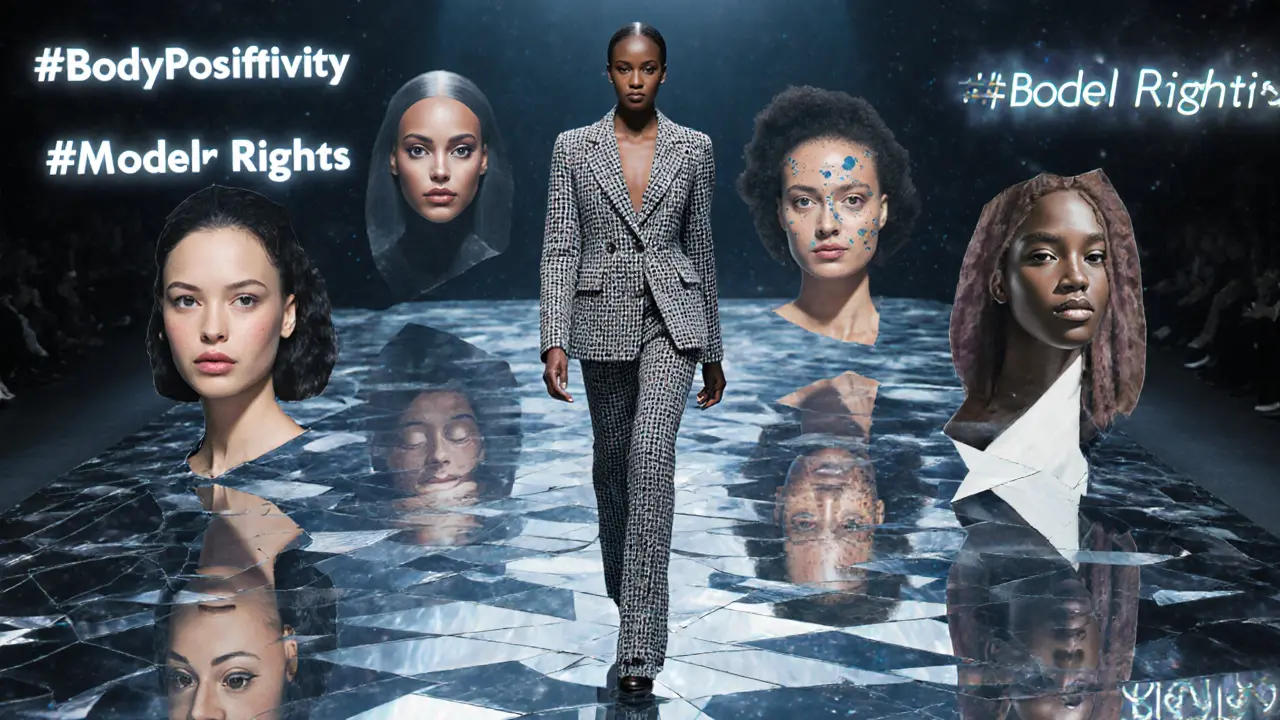You’ve seen them on billboards, magazine covers, and Instagram feeds-faces so iconic they don’t even need last names. Gisele. Naomi. Kate. Cindy. These aren’t just models. They’re cultural icons. But how did a teenager from a small town end up on the Paris runway, then in a Versace ad, then on the cover of Vogue? And what happens after the spotlight fades?
What Exactly Is a Top Model?
A top model isn’t just someone who walks in a fashion show. They’re the face of global brands, the ones designers trust to sell millions of dollars worth of clothes. These are the women and men who book campaigns for Chanel, walk for Chanel, and get paid six figures for a single day’s work. But it’s not just about looks. Top models have presence, discipline, and an ability to turn fabric into emotion.
Think of it this way: a regular model might show off a dress. A top model makes you want to buy the dress, the shoes, the perfume, and the lifestyle that comes with it. They don’t just wear clothes-they sell dreams.
How Do You Become a Top Model?
There’s no degree in becoming a top model. No university course. No certification. It’s raw talent, timing, and a whole lot of hustle.
- Scouting happens everywhere. Some are found in malls, others at school events. Gisele Bündchen was discovered at 14 in a Brazilian shopping center. Karlie Kloss was spotted while shopping in New York. You don’t need to be in Milan or Paris to get noticed.
- Agency matters. Top models sign with elite agencies-IMG, Ford, Women, DNA, or Elite. These agencies don’t just book jobs; they shape careers. They negotiate contracts, manage PR, and connect you with designers like Karl Lagerfeld or Alexander McQueen.
- It’s not just height and weight. Yes, most top models are tall (5’9” and up for women, 6’0”+ for men), but it’s the way they move, the way they hold their head, the way their eyes tell a story that separates them from the crowd.
- Consistency beats one-hit wonders. One runway show doesn’t make you famous. Three seasons in a row? That’s when brands start paying attention.
And don’t forget: the industry has changed. In the 90s, you needed to be flawless. Today, diversity matters. Curves, freckles, scars, different skin tones, non-binary identities-they’re all part of the new top model landscape. Brands don’t just want beauty. They want authenticity.
The Rise of the Supermodel Era
The 1990s were the golden age. Supermodels weren’t just models-they were rock stars. They had magazine covers, TV shows, perfume lines, and even their own wax figures at Madame Tussauds.
Naomi Campbell, Cindy Crawford, Claudia Schiffer, Linda Evangelista, and Tatjana Patitz didn’t just walk runways. They defined fashion. Linda famously said, “We don’t wake up for less than $10,000 a day.” That wasn’t bragging-it was the new normal.
They were on the same cover of Vogue together. They appeared in George Michael’s “Freedom! ’90” video. They became the first models to earn royalties from their image. That shift-from being hired hands to becoming brands themselves-changed everything.
From Runway to Real Life: What Happens After the Fame?
Not every top model stays famous forever. Some retire. Some pivot. Some crash.
Kate Moss didn’t fade away. She became a style icon, launched her own clothing line, and still appears in campaigns at 50. Naomi Campbell started her own foundation for young models. Gisele Bündchen became a UN Goodwill Ambassador and built a billion-dollar net worth through smart investments and eco-friendly brands.
But others struggled. The pressure, the scrutiny, the constant comparison-it breaks some. Eating disorders, depression, burnout. The industry didn’t protect them. Many models didn’t have financial advisors, therapists, or mentors. They were told to keep walking, keep smiling, keep starving.
Today, there’s more awareness. Agencies now offer mental health support. Contracts include clauses for rest days. Models speak out. And younger models are demanding better conditions.
Top Models Today: Who’s Leading the Pack?
The 2020s have a new breed of top models. They’re not just beautiful-they’re bold.
- Adut Akech-a South Sudanese refugee turned global sensation. Walked for Chanel, Saint Laurent, and Balmain. Became the first Black model to open a Chanel show in over a decade.
- Winnie Harlow-a model with vitiligo who turned her difference into her brand. Featured in Sports Illustrated, walked for Rihanna’s Savage X Fenty, and now hosts a reality show.
- Yasmin Wijnaldum-Dutch model who became the face of Prada, Fendi, and Versace. Known for her powerful walk and quiet confidence.
- Amber Valletta-a 90s icon who never left. Still booking major campaigns, now as a mentor to young models.
These aren’t just faces. They’re voices. They’re activists. They’re entrepreneurs. And they’re redefining what it means to be a top model in 2025.
How to Spot a Real Top Model
Not everyone with a big following is a top model. Here’s how to tell the difference:
- They work with top designers. If they’ve walked for Louis Vuitton, Dior, or Balenciaga in the last 12 months, that’s a sign.
- They’re in major editorial shoots. Vogue, Harper’s Bazaar, Elle-not just Instagram influencers.
- They’re paid by the brand, not the platform. Top models don’t need to post 10 times a day to earn. They’re hired for campaigns, not likes.
- They have agency representation. Real top models are represented by agencies that vet clients and negotiate pay. No one gets a $50,000 job without a contract.
Instagram followers? They help. But they don’t define status.
What It Really Costs to Be a Top Model
It’s not free. Even the most successful models started with debt.
- Portfolio shoots. $2,000-$10,000 for professional photos, hair, makeup, styling.
- Travel. Flying to New York, Milan, or Tokyo for castings. Often unpaid.
- Agent fees. Agencies take 15-20% of earnings. But they also get you the jobs that pay $50,000 a day.
- Training. Posing, walking, acting for the camera-many models take classes for months before booking their first job.
Most models work for free in the beginning. They build their book. Then, after 1-3 years, they start earning. The top 1% make millions. The rest? They hustle.

Top Models vs. Influencers: What’s the Difference?
| Aspect | Top Model | Influencer |
|---|---|---|
| Primary Platform | Runways, Magazines, Brand Campaigns | Instagram, TikTok, YouTube |
| Income Source | Designer contracts, editorial shoots | Sponsored posts, affiliate links |
| Agency Representation | Yes-elite modeling agencies | Often no, or talent managers |
| Industry Recognition | CFDA, IMG, Vogue | Follower count, engagement rate |
| Typical Earnings (Annual) | $50,000-$5M+ | $10,000-$500,000 |
| Longevity | Decades (if managed well) | Often 1-5 years |
Top models build legacy. Influencers build trends. One lasts. The other fades.
Frequently Asked Questions
Can you become a top model without moving to New York or Paris?
Yes. While New York, Paris, Milan, and London are still major hubs, agencies now scout globally. Models from Brazil, Nigeria, South Korea, and Australia are booking top jobs without relocating immediately. Many start locally, build their portfolio, and then get signed by international agencies. Social media has made geography less of a barrier.
Do top models have to be skinny?
Not anymore. The industry shifted after the 2000s health crisis. Today, brands want diversity in body types. Curve models, tall models, and models with muscular builds are in high demand. Designers like Savage X Fenty and Aerie actively cast models of all sizes. The focus is on health, confidence, and presence-not a number on a scale.
How old do you have to be to become a top model?
Most models start between 14 and 18, but there’s no upper limit. Models like Amber Valletta and Naomi Campbell are still working in their 40s and 50s. The key is relevance. Younger models often book teen and runway jobs. Older models land campaigns for luxury, beauty, and lifestyle brands. Age is just a number-if you’ve got the look and the discipline, you’ve got a shot.
Are top models rich?
The top 1% are. Gisele Bündchen, Adriana Lima, and Karlie Kloss have net worths over $100 million. But the average model? Not so much. Most earn modestly in their first few years. Only those who sign long-term contracts with major brands, launch their own products, or invest wisely build lasting wealth. Many models work side jobs-teaching, styling, writing-to stay afloat.
Is modeling a sustainable career?
It can be, but not without planning. Modeling is a young person’s game, but the smart ones use it as a launchpad. Many transition into acting, design, entrepreneurship, or philanthropy. Others become agents, photographers, or mentors. The key is to treat modeling as a stepping stone, not a lifelong job. Build skills, save money, and plan for what comes next.
Final Thought: It’s Not Just About Looks
Top models aren’t born. They’re built. Through rejection, early mornings, long flights, and silent moments of doubt. The ones who make it aren’t the prettiest. They’re the most persistent. The most adaptable. The ones who learn how to turn pressure into power.
So if you’re dreaming of the runway-go for it. But don’t just chase the spotlight. Chase the craft. Build your voice. Protect your worth. Because the real fame? It’s not on a magazine cover. It’s knowing you didn’t just walk the catwalk-you changed the game.




